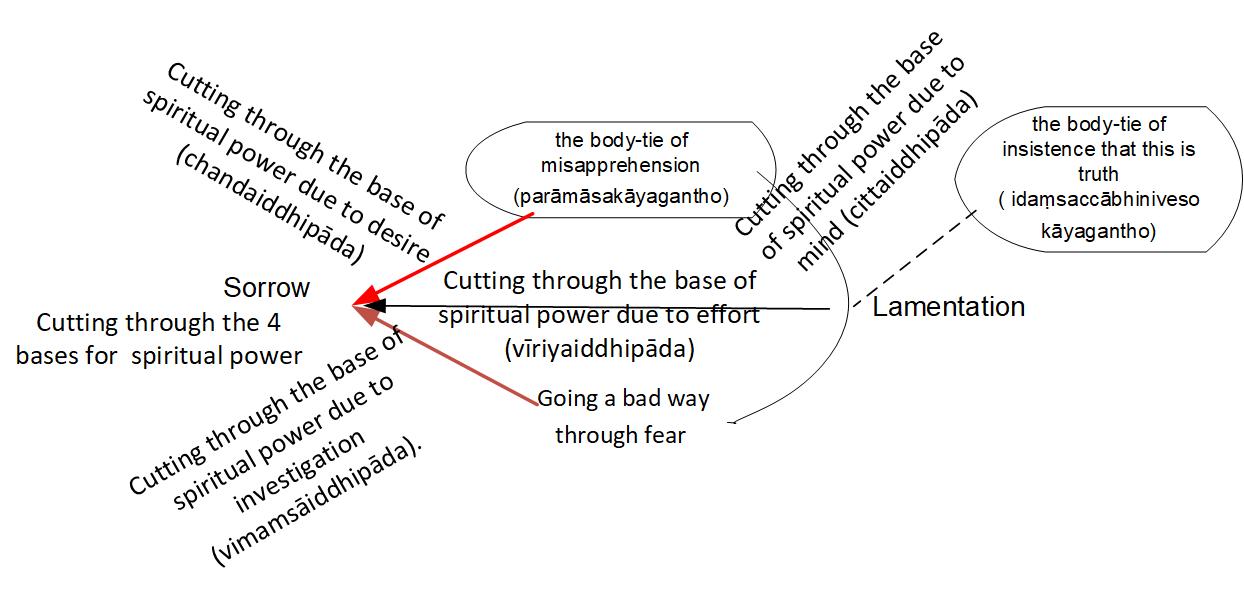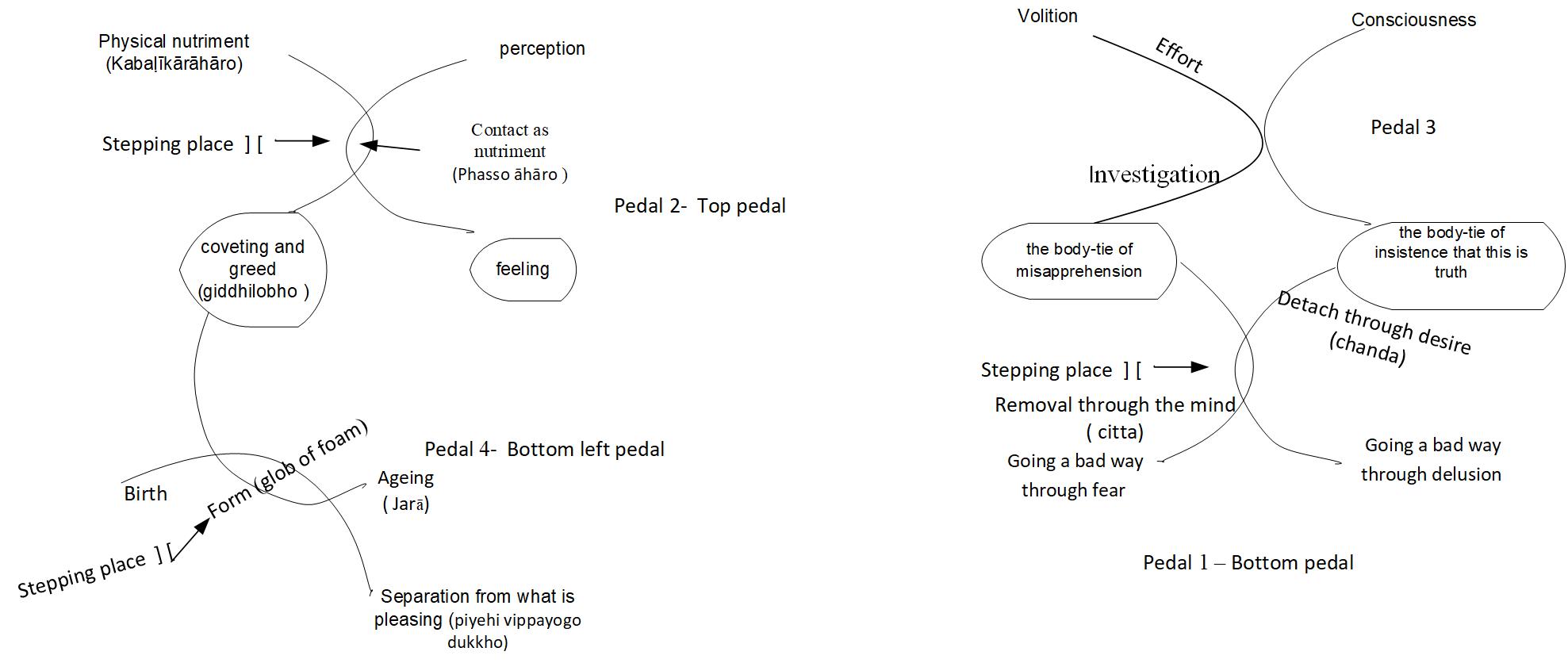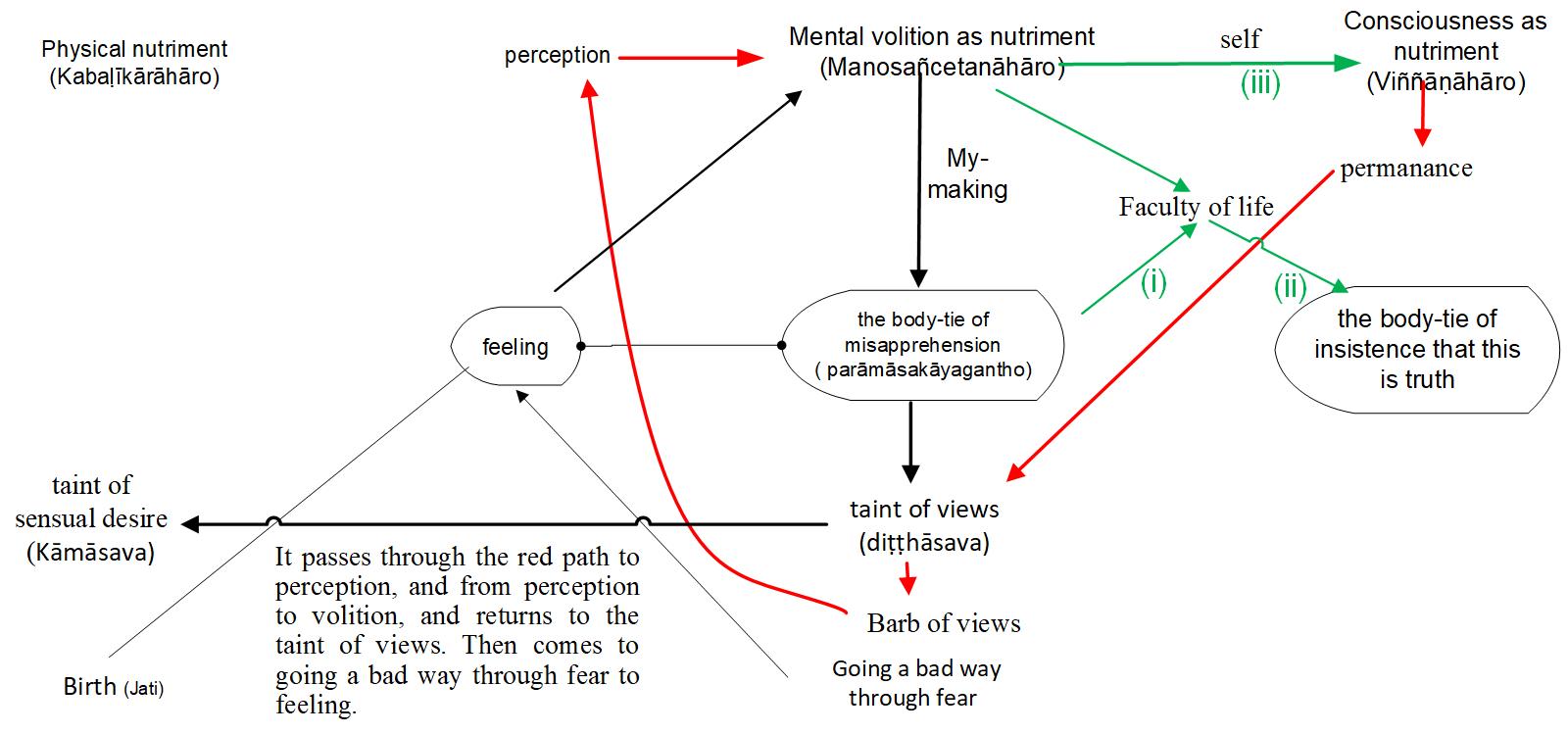The Noble Council of Akanittha Brahma Realm was remembered with faith.
I repeated the 31/01/2025 Nibbāna meditation. The paths 1, 2, 3, 4 arising through sorrow (soka), as given in the diagram in the 14/07/2015 Nibbāna meditation were recalled.
In today’s meditation, further examination was made on the dhamma that only if investigation (vīmaṃsā) becomes strong enough to prevent the arising of the path due to sorrow (soka), then consciousness will not arise with volitional formations as condition (saṅkhāra paccaya viññāṇa), meaning it can be stopped at point A.
Use the diagram that was learned in the Cattaro iddhipāda (four bases of spiritual power) meditation on 14/04/2015.

Then there is, through the base of spiritual power due to mind (citta iddhipāda), the cutting off from the ‘going a bad way through fear’ (bhayā agatigamanaṃ) to the body-tie of misapprehension (parāmāsakāyagantho). Next, through the base of spiritual power due to desire (chanda iddhipāda), cutting off from the body-tie of misapprehension (parāmāsakāyagantho) to sorrow (soka). Through concentration due to effort (viriya samadhi), cutting off from lamentation (parideva) to sorrow (soka). Through the base of spiritual power due to investigation (vimamsa iddhipāda), cutting off from the ‘going a bad way through fear’ (bhayā agatigamanaṃ) to sorrow (soka).
It was remembered that the Budu Piya said: ‘In whatever base of spiritual power due to desire (chanda iddhipāda) there is, two aspects of dhamma are included: the removal of volitional formations (sankhāra) and the non-occurrence of sorrow (soka). This shows that suffering exists in area 2. We will look at this later.
We know that when the base of spiritual power due to mind (citta iddhipāda) is present, it eliminates the momentum of volitional formations (sankhāra). Furthermore, it also includes the exposition that if there is any thought (saṅkappo) of pleasure (sukha), it does not arise through volitional formations (sankhāra). That is so. There is pleasure (sukha) that comes from the concentration due to mind (citta samadhi) arising through the removal of verbal formations (vaci saṅkhāra) like lying and harsh speech. It is not there by doing volitional formations (saṅkhāra). One realises this through personal experience. The removal of volitional formations (saṅkhāra) through the concentration due to desire (chanda samadhi) helped in this realisation. Thus, one understands that suffering exists in area 6.
The fact that suffering (dukkha) exists in thought (saṅkappo) was examined in the Nibbāna meditation on 10/01/2025. Examine the thought (saṅkappo) there. The Four Noble Truths are contained within it. Its influence extends up to contact (phassa). Thus, one understands that suffering exists in area 1. We know that the effort (viriya) doctrines were helpful for this. Use the principle that was used in examining the mental fixity (appanā) doctrine where 'the mind settles into studying the Sutta Pitaka.' Through effort (viriya), it shows that one should not use form (rupa), things like TV, but should use the Sutta Pitaka. Why? Because through desire (chanda), the foundation for this has been established.
Thus, again when one understands that suffering exists in both ends - the pedals of area 1 and area 6 - its functioning stops. It is remembered that the Budu Piya taught that only when effort (viriya) is well maintained, one does not progress from lamentation (parideva) to sorrow (soka). One should not engage in activities after knowing areas as suffering. Here, area 1 and area 6 can be thought of as- here, brahma worlds, here, USA, etc. To that extent, it must be nourished by the Four Noble Truths.
The fact that there is suffering in Area 2, is shown by the base of spiritual power due to desire (chanda iddhipāda). As discussed before, it's like repeatedly pointing a finger at a decaying form. Thus, one understands that suffering exists in area 6, area 1, and area 2. What remains are the form values on the path of conceit (māna). This can be marked from the ‘going a bad way through fear’ (bhayā agatigamanaṃ) to sorrow (soka). This is connected with the taint of existence (bhava āsava). We know that the taint of existence (bhava āsava) is marked near sorrow (soka). We know this is the post perception (sañña) of 'self' (attā).
Whatever volitional formation (sankhāra) was done before, the stoppage of the flow of conceit-values that arose from it must occur. When inquiring how investigation (vīmaṃsā) helps with this, it was learnt that whatever understanding of dependently arising (paṭiccasamuppanna) there is, it shows that all volitional formations (sankhāra) lead to suffering. Here, examine using the principle given by the Tapassi Budu Piya.

There we know that from self (attā) to permanence (nicca), conceit (māna) applies a 'jack', which prevents the progression from wisdom (paññā) to faith (saddhā). What should be used here as dependently arising (paṭiccasamuppanna) dhamma? Think of it as taking dhamma from self to permanence having lifted by conceit. Conceit (māna) is a mental formation (citta sankhara). The Budu Piya said that it arose from previously performed bodily, verbal, and mental formations (kāya vaci citta sankhara).
If one takes the decaying form as self (attā), then that ‘self’ contains suffering. If one becomes conceited (māna) about the decaying form, then that ‘conceit’ contains suffering. If one takes the decaying form as permanent (nicca) because of the above (two facts), then suffering is contained within that too. Only if the area, where consciousness (viññāṇa) is marked, is understood to be suffering, then one comprehends that consciousness arising with volitional formations as condition (saṅkhāra paccaya viññāṇa) is suffering.
That is the meditation.
So, to add a little more to this,
1. 100 beings will attain Nibbāna from this meditation.
2. Further examining the principle given by Tapassi Budu Piya, we know that progressing dhamma from self (attā) to permanence (nicca) destroys wisdom (paññā). From this, faith (saddhā) is lost. Therefore, we must keep in mind that due to not knowing each dependently arising (paṭiccasamuppanna) dhamma, wisdom (paññā) is destroyed and consequently faith (saddhā) is lost. When examining the four pedals, dependently arising (paṭiccasamuppanna) exists in all four corners. Examine this with the diagram given during the Chanda Iddhi paricita meditation on 19/05/2015.

Pedal 1: When examining the bottom pedal, there are volitional formations arising with ignorance as condition (avijjā paccaya sankhāra).
Pedal 2: When examining the top pedal, there are feelings arising with contact as condition (phassa paccaya vedanā).
Pedal 3: When examining, there are name-and-form arising with consciousness as condition (viññāṇa paccaya nāmarūpam).
Pedal 4: When examining, there is birth (jāti) occurring due to delight (nandi), and aging (jarā) occurring due to birth (jāti).
Thinking that there are many dependently arising principles, the Budu Piya said that if the foremost principle of dependent arising is understood, then to the minds that has been elevated by this understanding, the other dependently arising phenomena become evident.
3. Keeping in mind the second point added here; remembering that consciousness is lasting for a very brief moment and concentration due to desire (chanda-samādhi) removes volitional formations (sankhāra), when one recalls the dependently arising (paṭiccasamuppanna) doctrine that hate arises due to killing and killing arises due to hate, true knowledge and liberation (vijjā-vimutti) arises immediately. (*1)
4. When examining the section on the base of spiritual power due to mind (citta iddhipāda), examine the thought (saṅkappo) there. The Four Noble Truths are included in it. Its influence extends up to contact (phassa). It was said that in this way, one understands that there is suffering in area 1. How does it reach area 1? As the momentum of misapprehension (parāmāsa) decreases, the momentum from the misapprehension (parāmāsa) to sorrow (soka) also decreases.. Whatever underlying tendency to views (diṭṭi anusaya) assigns pleasure (sukha) to form (rūpa), the base of spiritual power due to mind (citta iddhipāda) also shows that it is not pleasure (sukha). It is viewed with the idea that it contains suffering. This is why. The perception of pleasure (sukha saññā) has the characteristic of the strong grasping of contacts that lead to taints (āsava). Thus, contemplate with the meaning of the Bhūta (becoming) diagram from 07/11/2015 which is led to spin through the doctrines coming from the top and the barb of lust (rāga salla) from the bottom.

5. When contemplating this meditation with the fourth point mentioned, all bases of spiritual power (iddhipāda) exist in such a way that the differences between each base of spiritual power (iddhipāda) cannot be distinguished. That is, whether one is contemplating effort (viriya), desire (chanda), or investigation (vīmaṃsā), the mind remains in the same state. It is very pleasant to be like this. However, there is no stopping at any point. Why? Because there is the realisation that through each path, form (rūpa) is removed.
That is what needs to be added.
Footnotes added during the discussion
(*1) Then the left side first opened, with that, the fruit of the attainment arose, after that, on the right side, liberation by wisdom occurred.